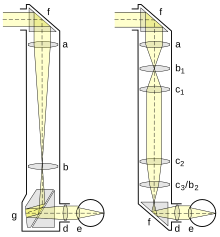
a Mirrors
b Prisms
c Observer's eye

a Objective lens
b Field lens
c Image erecting lens
d Ocular lens
e Lens of the observer's eye
f Right-angled prism
g Image-erecting prism
A periscope is an instrument for observation over, around or through an object, obstacle or condition that prevents direct line-of-sight observation from an observer's current position.[1][2]
In its simplest form, it consists of an outer case with mirrors at each end set parallel to each other at a 45° angle. This form of periscope, with the addition of two simple lenses, served for observation purposes in the trenches during World War I. Military personnel also use periscopes in some gun turrets and in armoured vehicles.[1]
More complex periscopes using prisms or advanced fiber optics instead of mirrors and providing magnification operate on submarines and in various fields of science. The overall design of the classical submarine periscope is very simple: two telescopes pointed into each other. If the two telescopes have different individual magnification, the difference between them causes an overall magnification or reduction.
- ^ a b Walker, Bruce H. (2000). Optical Design for Visual Systems. SPIE Press. p. 117. ISBN 978-0-8194-3886-7.
- ^ The Submarine Periscope: An Explanation of the Principles Involved in Its Construction, Together with a Description of the Main Features of the Barr and Stroud Periscopes. Barr and Stroud Limited. 1928.